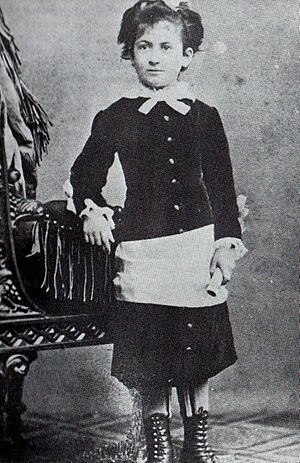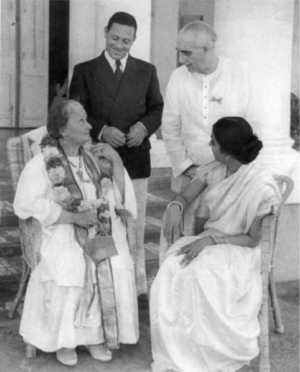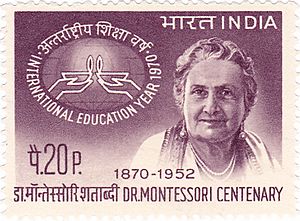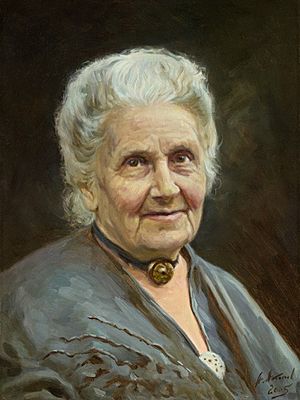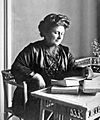Maria Montessori facts for kids
Quick facts for kids
Maria Montessori
|
|
|---|---|
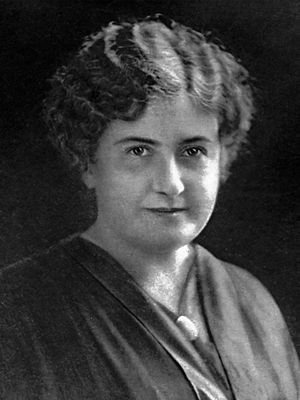
Portrait of Montessori, artist and date unknown
|
|
| Born |
Maria Tecla Artemisia Montessori
31 August 1870 Chiaravalle, Marche, Kingdom of Italy
|
| Died | 6 May 1952 (aged 81) Noordwijk, South Holland, Netherlands
|
| Resting place | Noordwijk, Netherlands |
| Education | University of Rome La Sapienza Medical School |
| Occupation |
|
| Known for | Founder of the Montessori method of education |
| Children | 1 |
| Signature | |
Maria Montessori (born August 31, 1870 – died May 6, 1952) was an amazing Italian doctor and teacher. She is famous for creating a special way of teaching called the Montessori method. This method helps children learn by exploring and discovering things on their own.
When she was young, Maria wanted to be an engineer. But then she changed her mind and decided to study medicine. She became one of the first women in Italy to go to medical school. She graduated with honors in 1896. Today, her teaching method is used in many schools all over the world.
Contents
- Maria Montessori's Life and Work
- Montessori's Educational Ideas
- The Montessori Method
- Maria Montessori's Legacy
- Maria Montessori's Books
- Images for kids
- See also
Maria Montessori's Life and Work
Early Life and Family
Maria Montessori was born on August 31, 1870, in a town called Chiaravalle, in Italy. Her father, Alessandro Montessori, worked for the government. Her mother, Renilde Stoppani, was very well-educated for her time. Maria was very close to her mother, who always encouraged her to learn. Her father also loved her, even though he didn't always agree with her choices about education.
Becoming a Doctor: Maria's Education
Starting School and Moving Around
Maria's family moved a few times when she was little. First to Florence in 1873, then to Rome in 1875. She started elementary school in 1876 when she was six years old. Her early school reports weren't super special. But she did get awards for good behavior and for "women's work."
High School and New Dreams
When Maria was about 13, she went to a technical high school. She studied subjects like Italian, math, history, and science. She did very well, especially in math and science.
At first, she wanted to become an engineer. This was a very unusual goal for a girl back then! But by the time she graduated at age 20, she decided to study medicine instead. This was even more uncommon for a woman in her time.
Medical School Challenges
Maria was determined to study medicine. She faced many challenges because she was a woman. Some male students and professors were not welcoming. She even had to do her dissections (studying bodies) alone after hours.
Despite these difficulties, Maria was a brilliant student. She won an academic prize in her first year. In 1895, she became a hospital assistant, which gave her early experience with patients. She focused on studying children's health and mental health. In 1896, Maria graduated from the University of Rome as a doctor of medicine. She then worked at the university hospital and also had her own private practice.
Early Career and Family Life
From 1896 to 1901, Maria Montessori worked with children who had learning difficulties. These children were sometimes called "phrenasthenic" at the time. She also started traveling, studying, speaking, and publishing her ideas. She became well-known for supporting women's rights and education for children with special needs.
Maria had one son, Mario Montessori, who was born in 1898. She chose to focus on her career and studies. Later, Mario became a great helper in her research and work.
Helping Children with Learning Difficulties
After becoming a doctor, Maria continued her research at the university's mental health clinic. She visited places where children with mental disabilities lived. Her observations there were very important for her future teaching methods. She also studied the ideas of other doctors and educators like Jean Marc Gaspard Itard and Édouard Séguin. These thinkers greatly influenced her. Maria created a more organized way to help children with disabilities learn.
Speaking Up for Education
Maria also became a public speaker. In 1897, she talked about how society should help young people who get into trouble. In 1898, she wrote articles and spoke at a conference. She asked for special classes and schools for children with learning difficulties. She also pushed for teachers to be trained to work with these children.
In 1899, Maria became an advisor for a new group called the National League for the Protection of Retarded Children. She also gave lectures on special teaching methods.
The Orthophrenic School
In 1900, the National League opened the Orthophrenic School. This school was a special place to train teachers to educate children with learning difficulties. Maria was one of the directors. Teachers learned about psychology, the brain, and special teaching methods.
During her two years at this school, Maria developed many teaching methods and materials. She later used and changed these ideas for all children, not just those with learning difficulties. The school was very successful. Some children who were thought to be "uneducable" even passed public exams given to other children.
More Studies and New Ideas
In 1901, Maria left the Orthophrenic School and her private practice. She went back to the University of Rome to study philosophy, which included psychology at the time. She also studied anthropology and educational ideas on her own. She visited elementary schools to observe children and translated important books about education. During this time, she started thinking about using her methods for all children.
Maria continued to develop what she called "scientific pedagogy." This meant using scientific observation to improve education. In 1904, she became a lecturer in anthropology at the University of Rome. Her lectures were later published as a book called Pedagogical Anthropology.
The First Children's House: Casa dei Bambini
Opening the First Casa
In 1906, Maria Montessori was asked to help with a group of children in a new apartment building in Rome. These were children of working parents from low-income families. Maria was excited to try her teaching methods with children who did not have learning disabilities.
The first Casa dei Bambini, or Children's House, opened on January 6, 1907. It had about 50 to 60 children between the ages of two or three and six or seven.
What Happened in the Classroom
At first, the classroom had regular furniture. But Maria observed the children closely. She noticed that they loved practical activities like dressing themselves, dusting, and sweeping. They were also very interested in the special materials Maria had developed. They showed deep focus and would repeat activities many times. They also liked order in their environment.
Maria changed the classroom based on what she saw. She replaced heavy furniture with child-sized tables and chairs that children could move. She put child-sized materials on low shelves so children could reach them easily. She added more practical activities like arranging flowers, washing hands, and even cooking. She also made sure children could move freely around the room.
Maria believed that children could learn independently and become self-motivated. She also felt that treating each child as an individual helped them learn better. She kept refining her materials and allowed children to choose their own activities and work without being interrupted. She realized that the teacher's job was to observe and guide the children's natural development.
How Montessori Education Grew in Italy
The first Casa dei Bambini was a big success. A second one opened soon after. The children in these programs continued to show great focus and self-discipline. Important educators and journalists started to notice Maria's work.
In 1907, Maria began to experiment with materials for teaching writing and reading. She used sandpaper letters and movable cutout letters. Children as young as four and five years old quickly learned to write and read much better than expected for their age. This brought even more attention to her work.
By 1908, three more Children's Houses opened. In 1909, Maria held her first training course for teachers in her new method. That same year, she wrote a book explaining her observations and methods, called The Method of Scientific Pedagogy. More training courses followed in Rome and Milan. Maria's reputation and work began to spread around the world. She eventually stopped practicing medicine to focus entirely on her educational work and training teachers.
Montessori Goes Global
By 1909, people from other countries started visiting Maria's schools. Her work was published widely and spread quickly. By the end of 1911, Montessori education was officially used in public schools in Italy and Switzerland. It was also planned for the UK. By 1912, Montessori schools opened in many European cities and were planned for countries like Argentina, China, India, Japan, and the United States.
Maria's book, The Montessori Method, became a bestseller in the US. She also published Doctor Montessori's Own Handbook, which was a practical guide to her teaching materials.
Montessori in the United States
Maria's work became very popular in the US around 1911 and 1912. The first Montessori school in North America opened in New York in 1911. Even the famous inventor Alexander Graham Bell and his wife supported the method.
Maria visited the United States in 1913 for a lecture tour. She showed films of her classrooms in Europe and met with large, excited crowds. In 1915, she returned to demonstrate her work at a big exhibition in San Francisco. She set up a special glass-walled classroom where thousands of people could watch her students.
However, not everyone supported Montessori's ideas in the US. Some educators criticized her method, saying it was too strict or didn't allow enough imagination and play. Also, Maria wanted to control how her method was used and taught, which caused some disagreements. After she left in 1915, the Montessori movement in the US became less popular until 1952.
Developing Montessori Education Further
In 1916, Maria moved to Barcelona, Spain. For the next 20 years, she traveled and lectured a lot in Europe. She also gave many training courses for teachers. Montessori education grew a lot in Spain, the Netherlands, the UK, and Italy during this time.
Montessori in Spain
In Barcelona, Maria continued her work. A small program grew into the Escola Montessori, serving children from ages three to ten. She also opened a research and training institute. In 1916, she taught a course that included new ways to teach grammar, arithmetic, and geometry to elementary school children.
Maria published a book for elementary school work called Self-Education in Elementary School. Later, political changes in Spain made it difficult for her work to continue. In 1924, a new government closed her model school. Maria left Spain permanently in 1936 because of the Spanish Civil War.
Montessori in the Netherlands
In 1917, Maria lectured in Amsterdam, and the Netherlands Montessori Society was formed. Montessori programs grew very well in the Netherlands. By the mid-1930s, there were over 200 Montessori schools there. In 1935, the main office for the Association Montessori Internationale (AMI) moved to Amsterdam.
Montessori in the United Kingdom
Montessori education was also popular in England. Maria visited England for the first time in 1919 and gave a very popular training course. Montessori education continued to spread in the UK. Maria kept giving training courses in England every other year until World War II began.
Montessori in Italy
In 1922, Maria was invited back to Italy by the government. She gave lectures and visited Italian Montessori schools. The government, led by Benito Mussolini, supported Montessori education as part of their national plan. Maria met with Mussolini, and he became an honorary president of the Opera Montessori (Montessori Society).
However, Maria and the Italian government later disagreed, especially about her ideas on Peace and Education. In 1932, she and her son were watched by the government. In 1933, she left the Opera Montessori, and in 1934, she left Italy. The Italian government stopped supporting Montessori activities in 1936. Maria's strong anti-fascist views led to her exile. During this time, she developed her ideas on "Education for Peace," believing that children are peacemakers and education is the best way to prevent war.
Other Countries and Peace Work
Between 1913 and 1936, Montessori schools and groups were also started in many other countries, including France, Germany, Russia, Canada, India, China, and Japan.
In 1929, the first International Montessori Congress was held in Denmark. Here, Maria and her son Mario created the Association Montessori Internationale (AMI). This organization helps oversee Montessori schools and teacher training worldwide. Famous thinkers like Sigmund Freud and Jean Piaget supported AMI.
Maria also became very involved in promoting peace. From 1932 to 1939, she held peace conferences in different cities. She believed that education, especially for children, was key to creating a peaceful world. Her lectures on peace were published in a book called Education and Peace. She was nominated for the Nobel Peace Prize six times between 1949 and 1951.
In 1936, Maria and her family moved to Laren, near Amsterdam. Here, she and Mario continued to create new teaching materials. As tensions grew in Europe before World War II, Maria focused more on the idea of peace. In 1937, the 6th International Montessori Congress was about "Education for Peace." Maria called for a "science of peace" and said that educating children was vital for improving society.
Montessori in India
Maria Montessori had been connected to the Theosophical Society since 1899. This group was interested in educating India's poor and saw Montessori education as a solution. In 1938, Maria was invited to India by the Theosophical Society to give a training course. She left the Netherlands with her son Mario in 1939.
Staying in India During the War
Maria gave a training course in Madras in 1939. She planned to tour universities and then return to Europe. But when Italy joined World War II in 1940, Britain held all Italians in the UK and its colonies as "enemy aliens." Mario was held for a short time, but Maria was allowed to stay at the Theosophical Society. They remained in India until 1946.
New Ideas from India
During their years in India, Maria and Mario continued to develop her teaching methods. They introduced the idea of "cosmic education" for children aged six to twelve. This approach teaches children about how everything in the natural world is connected. Children worked with plants and animals. Maria and Mario created new lessons, charts, and models for subjects like botany, zoology, and geography. This work led to two books: Education for a New World and To Educate the Human Potential.
Maria also studied babies and young children while in India. In 1944, she gave lectures on the first three years of life. These lectures were later put into a book called What You Should Know About Your Child.
In 1945, Maria attended the first All India Montessori Conference. In 1946, after the war ended, she and her family returned to Europe.
Final Years and Lasting Impact
In 1946, at age 76, Maria returned to Amsterdam. For the next six years, she traveled in Europe and India. She gave training courses in London and Italy. She also returned to India to give more courses. These courses led to her book The Absorbent Mind, which explains how children develop from birth. In this book, she described her idea of the Four Planes of Development, which are different stages of growth for children.
In 1948, her book The Method of Scientific Pedagogy was revised and published in English as The Discovery of the Child. In 1949, she gave a course in Pakistan, and the Pakistan Montessori Association was founded.
Maria returned to Europe in 1949. She attended the 8th International Montessori Congress in Italy. She was nominated for the Nobel Peace Prize again. She also received important awards like the French Legion of Honour and an honorary doctorate from the University of Amsterdam.
In 1950, she visited Scandinavia and represented Italy at a UNESCO conference. She was nominated for the Nobel Peace Prize for the second time. In 1951, she participated in the 9th International Montessori Congress in London and was nominated for the Nobel Peace Prize for the third time.
Maria Montessori was directly involved in creating the UNESCO Institute for Education in 1951. She spoke at UNESCO meetings, pointing out that while there was a "Universal Declaration of Human Rights," there was no "Declaration of the Rights of the Child." She felt children's rights needed to be specifically recognized.
Death
Maria Montessori passed away from a brain hemorrhage on May 6, 1952, in the Netherlands. She was 81 years old.
Montessori's Educational Ideas
How Her Ideas Started
Maria Montessori's teaching ideas were first shaped by the work of other educators like Jean Marc Gaspard Itard, Édouard Séguin, Friedrich Fröbel, and Johann Heinrich Pestalozzi. These people believed in learning through exploring with your senses and using special tools. Maria used their methods when she first worked with children who had learning difficulties. She trained children in everyday activities and helped them use their senses. These activities later became the "Sensorial" materials in Montessori schools.
What is Scientific Pedagogy?
Maria called her work "scientific pedagogy." This meant not just watching and measuring students, but also creating new ways to help them grow and improve. She believed that education should be changed by science to help each person become better.
The Casa dei Bambini Method
When Maria worked with children who did not have disabilities in the Casa dei Bambini in 1907, she started to create her own teaching method. The main ideas of her method came from observing these children. She saw that when children were free to act in an environment made for their needs, they showed a natural way of developing. She believed that teachers should remove anything that stops this natural development and give children chances to learn and grow.
So, she filled the classrooms with child-sized furniture and "practical life" activities like sweeping and washing tables. She also used special teaching materials she had made. Children were free to choose their own activities, work at their own speed, and follow their own interests.
In these conditions, Maria noticed several important things. First, children showed great concentration and would repeat chosen activities many times. They also liked to keep their environment tidy. As children chose some activities more than others, Maria improved the materials she offered. Over time, the children started to show what she called "spontaneous discipline."
Montessori Today
Maria continued to develop her teaching ideas as she worked with older children. She believed that human behavior is guided by natural, inborn traits. Her son, Mario, later called these "human tendencies." She also noticed four different stages, or "planes," in human development: from birth to six years, six to twelve, twelve to eighteen, and eighteen to twenty-four. She believed each stage needed a different way of teaching.
Maria created teaching methods and materials for the first two stages (birth to age twelve). She also wrote and lectured about the third and fourth stages. Maria helped create over 4,000 Montessori classrooms around the world. Her books were translated into many languages to train new teachers. Her methods are still used in hundreds of public and private schools in the United States and globally.
The Montessori Method
One of Maria Montessori's biggest achievements was creating the Montessori method. This is a way of teaching young children that focuses on helping them develop their own initiative and natural abilities. Children learn best through hands-on activities and play. This method lets children learn at their own speed and helps teachers understand how children develop.
Maria's book, The Montessori Method, explains her ideas in detail. Teachers who follow this method create special classrooms for children in three age groups: 2 to 2.5 years, 2.5 to 6 years, and 6 to 12 years. Students learn by exploring, using special materials, and repeating activities. Teachers encourage younger children to use their senses to explore their environment. Older children work with more complex ideas, using their reasoning, imagination, and creativity.
Maria Montessori's Legacy
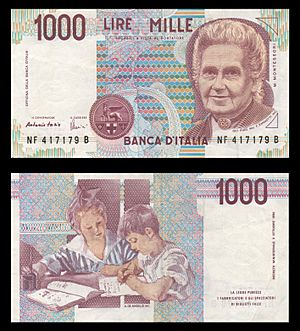
Maria Montessori and her schools have been honored on coins and banknotes in Italy. She has also appeared on stamps in the Netherlands, India, Italy, the Maldives, Pakistan, and Sri Lanka.
A KLM airplane was named after her. In 2020, Time magazine named Maria Montessori as one of the Top 100 Women of the year.
Maria Montessori's Books
Maria Montessori wrote many books, articles, and pamphlets during her life. Many were first published in Italian, but some came out in English first. Her main works published before 1920, like The Montessori Method and Pedagogical Anthropology, were written by her and translated under her guidance. Later, many of her books were put together from her lectures. Most of her works are available through the Montessori-Pierson Publishing Company.
Here are some of her most important books:
- Il Metodo della Pedagogia Scientifica (The Method of Scientific Pedagogy) (1909)
- English edition: The Montessori Method (1912)
- Later revised and published as The Discovery of the Child (1948)
- Antropologia Pedagogica (Pedagogical Anthropology) (1910)
- English edition: Pedagogical Anthropology (1913)
- Dr. Montessori's Own Handbook (1914)
- L'autoeducazione nelle scuole elementari (Self-Education in Elementary Schools) (1916)
- English edition: The Advanced Montessori Method, Vol. I: Spontaneous Activity in Education (1917)
- Das Kind in der Familie (The Child in the Family) (1923)
- Psico Geométria (Psychogeometry) (1934)
- L'Enfant (The Child) (1936)
- English edition: The Secret of Childhood (1936)
- De l'enfant à l'adolescent (From Childhood to Adolescence) (1923)
- Educazione e pace (Education and Peace) (1949)
- Formazione dell'uomo (The Formation of Man) (1949)
- The Absorbent Mind (1949)
- Education for a New World (1947)
- To Educate the Human Potential (1947)
Images for kids
See also
 In Spanish: Maria Montessori para niños
In Spanish: Maria Montessori para niños


